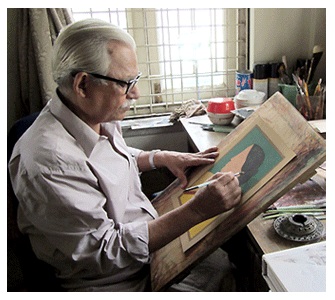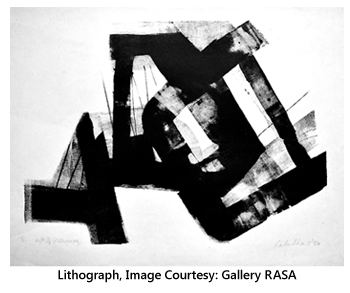- Publisher's Note
- Editorial
- Sixteen printmakers talk about their work
- The Imprinted Body
- A Chai with Vijay Bagodi
- The Wood Engravings of Haren Das
- A Physical Perception of Matter
- Feminine Worlds
- A Rich Theater of Visuality
- A Medley of Tradition
- Decontextualizing Reality
- Printmaking and/as the New Media
- Conversations with Woodcut
- Persistence of Anomaly
- Sakti Burman - In Paris with Love
- Lalu Prasad Shaw: The Journey Man
- Future Calculus
- A Note on Prints, Reproductions and Editions
- A Basic Glossary of Print Media
- The Art of Dissent: Ming Loyalist Art
- Vishnu: Hinduism's Blue-Skinned Savior at the Brooklyn Museum of Art
- Twelfth edition of Toronto International Art Fair
- Vintage Photographs of the Maharajas
- Göteborg International Biennial
- A Museum, a Retrospect & a Centenary for K.K. Hebbar:
- Recent and Retrospective: Showcase of Shuvaprasanna's Work
- "I Don't Paint To Live, I Live To Paint": Willem de Kooning
- Salvador Dali Retrospective: I am Delirious, Therefore I am
- To Be Just and To Be Fair
- Census of Senses: Investigating/Re-Producing Senses?
- Between Worlds: The Chittaprosad Retrospective
- Awesomely Artistic
- Random Strokes
- Counter Forces in The Printmaking Arena and how to Counter them
- Shift in focus in the Indian Art Market
- What Happened and What's Forthcoming
- Art Bengaluru
- Mumbai Art Sighting
- Musings from Chennai
- Art Events Kolkata
- Previews
- In the News
ART news & views
Lalu Prasad Shaw: The Journey Man
Volume: 4 Issue No: 21 Month: 10 Year: 2011
Profile
Lalu Prasad Shaw was born in Siuri; district Birbhum in the year 1937. As he was growing up,  a sudden incident changed the way he looked at life. From his house the workplace of the Malakars could be seen. They sculpted idols and drew several kinds of patas that were to be placed behind the idols of the gods. Gradually, an ambition to become an artist grew within him. Each day while returning from school, he picked up local colours in his hands and prepared to draw pictures according to the desires of his mind.
a sudden incident changed the way he looked at life. From his house the workplace of the Malakars could be seen. They sculpted idols and drew several kinds of patas that were to be placed behind the idols of the gods. Gradually, an ambition to become an artist grew within him. Each day while returning from school, he picked up local colours in his hands and prepared to draw pictures according to the desires of his mind.
When Shaw was in class VIII, Pinakinath Bhattacharya was appointed in his school as the art teacher. He often formed a troop with these students and went outdoors to draw the landscapes of the red soil.
Though Shaw was passionate about art, he never thought of converting it into a profession. During the years of his adolescence, what most flaunted the Bengal art scene was the presence of Abanindranath and Gaganendranath's works. The monthly Basumati, Prabasi and Modern Review projected their works at regular intervals. Shaw updated himself with such works through these magazines, and he started copying those works.
He was admitted at Indian College of Art & Draftsmanship, Kolkata in 1953 but after a few months he left and was admitted at Govt. College of Art & Craft, Kolkata in 1954. At this time almost all artists who planned to take up art professionally engaged into the field of commercial or applied art. Everybody learnt how to design the cover of a book, an advertisement or the works of lettering.  Even Shaw admitted himself to the art college with a vision of learning the same. However, with the passage of time, like any creative mind would know, Shaw also realized the difference between an artistic mind and a machine. He could not mechanically learn the sectors which he thought he would learn at the art college. He could not abide by the fixed technicalities of an advertising graphics or the cover of a book. Shaw decided to change his studies for the better.
Even Shaw admitted himself to the art college with a vision of learning the same. However, with the passage of time, like any creative mind would know, Shaw also realized the difference between an artistic mind and a machine. He could not mechanically learn the sectors which he thought he would learn at the art college. He could not abide by the fixed technicalities of an advertising graphics or the cover of a book. Shaw decided to change his studies for the better.
Ajit Gupta was his favourite teacher in his first year at Art College. In his second year he had Gopal Ghosh, Rathin Maitra, Anil Bhattacharya and Maniklal Bandopadhyay as his teachers. Even today when Shaw works on tempera, the influences of Ajit Gupta's work in his style are too big to ignore.
Several incidents of social and political importance had already occurred by then. The Second World War ended, India became independent, riots took place, famines occurred. The most vital question that rose out of this turmoil was the question of independent modes of thought and existence. Each artist wanted to be free in his mode of expressions. The search was referred to as the one 'in search of identity'. Shaw himself subjected his mind to be a victim of this turmoil. An institutional pedagogy rose in revolt against his choice of the expressive mode. Shaw allowed these extreme sides to negotiate between themselves and form a third personal style.
Shaw by then devised an original style, motto and vision which does not necessarily follow any institutional schooling. He wanted to come out of the trainings of the art college, he wanted to come out of academic practices.  However he soon felt that any deviation demanded the establishment of a primary ideal. Only then can that ideal be broken. He started practicing abstracts and broke himself free of forms.
However he soon felt that any deviation demanded the establishment of a primary ideal. Only then can that ideal be broken. He started practicing abstracts and broke himself free of forms.
In 1967, he joined the 'Society of Contemporary Artists'. Artist Sanat Kar introduced him to graphic prints for the first time. Suhas Roy returned from Paris and taught Shaw the techniques of etching. Thus, he submerged himself, from 1966-1973, in the practice of printmaking. After joining the society he started concentrating on etching from 1967. He felt that his interest towards two-dimensionality increased manifold times. In parallel he also devoted his skills in developing the drama of chiaroscuro. His abstractions however were never diluted abstractions. His works were based on formative abstraction. For the next eighteen years, his practice of graphic prints remained initiated. What he resumed, however, was his efforts in tempera. He explains:
"In the meantime, I joined my alma mater as a teacher. Satyen Ghoshal, who was once my teacher, was the principal then…. At the art college I could do only etching. Later, when I joined Kala Bhavana, I did lithography and tempera painting simultaneously.... I do not know whether my return to figuration in tempera from abstraction in printmaking has something to do with my native roots. All I know is despite their dissimilarity, my prints and painting reflects the same penchant for experimentation with form and space, image and ground relationship, harmony and balance."
Shaw cannot be understood without understanding his works in print. He worked constantly both in etching and lithography. He remained in the Society of Contemporary Artists to work in etching. Later in Santiniketan, he worked on lithographic prints. In 1973, under the able guidance of Somenath Hore, Shaw re-designed the department of printing at Kala Bhavana. In this regard, he says:
"I started doing litho prints when I joined Kala Bhavana, Santiniketan in the late seventies. My lithography shows a calligraphic bias. The calligraphic elements that my etchings earlier had, formed a new expression in the new medium. The ambience that Kala Bhavana as an Institute of Art offered and an overall interest in the art of the Far-East at Santiniketan and also immensely aroused  my interest and made me interested to assimilate the magic of the art of the Far-East in my lithographs. I too have imbibed some of the qualities of the eastern art in my lithography. That is the background of my lithographic endeavour."
my interest and made me interested to assimilate the magic of the art of the Far-East in my lithographs. I too have imbibed some of the qualities of the eastern art in my lithography. That is the background of my lithographic endeavour."
In the context of etching, he informs that he started the work only as a member of the Society of Contemporary Artists. He says:
“… during the sixties, I, with co-members of the Society of Contemporary Artists, started pulling out graphic prints. Etching was our medium as the society had its own etching press. The prints the other members of the society showed in an exhibition impressed me immediately and I also started handling the medium with them. An exhibition of graphic prints from Czechoslovakia came to Calcutta. This exhibition inspired me for the strong and bold use of black and white. Initially, to master the medium, I did some exercise and gradually started pulling out art designs conceived in geometric forms. These initial prints showed static structural motifs, but I was conscious of the motifs... In prints, the designs attained flexibility and plasticity… Instead of illusion of depth, I tried to explore the basics of the forms. The prints I did earlier comparatively look a bit static and rigid. In the subsequent prints I stressed the structural and compositional aspects of the forms and tones, and the textures that helped the forms to come out clearly. The whiteness of the paper gave them clarity."
These are the two episodes of Shaw's printing endeavour. Etching and lithography, as part of Shaw's journey in fact enriched not only Bengal's but the entire nation's printmaking scenario. Thus Shaw kept printing and several modes of painting side-by-side. On one side he worshipped forms, on the other he captured the music of the formless; the abstract. Today, as he still progresses, he says with confidence:
"I talked in the language of my images. I did not want to add a literary meaning to my works always. I just wanted to create an image...This however is true, that I myself have enjoyed my work always… In some places I have kept regular homely elements, elsewhere I have deliberately distorted them to break the monotony. The practice of art, to me, is actually a journey. I am the journey man."